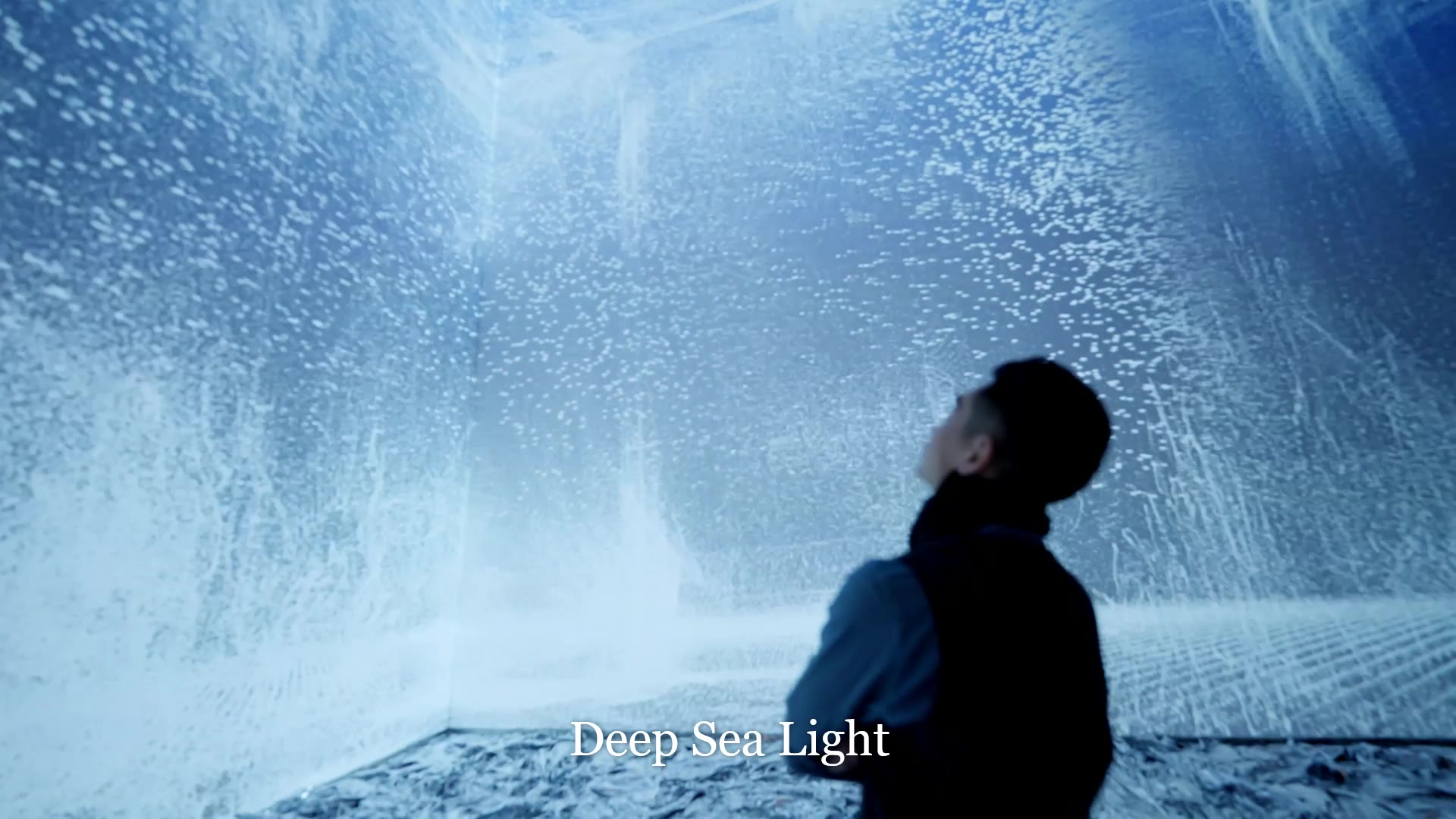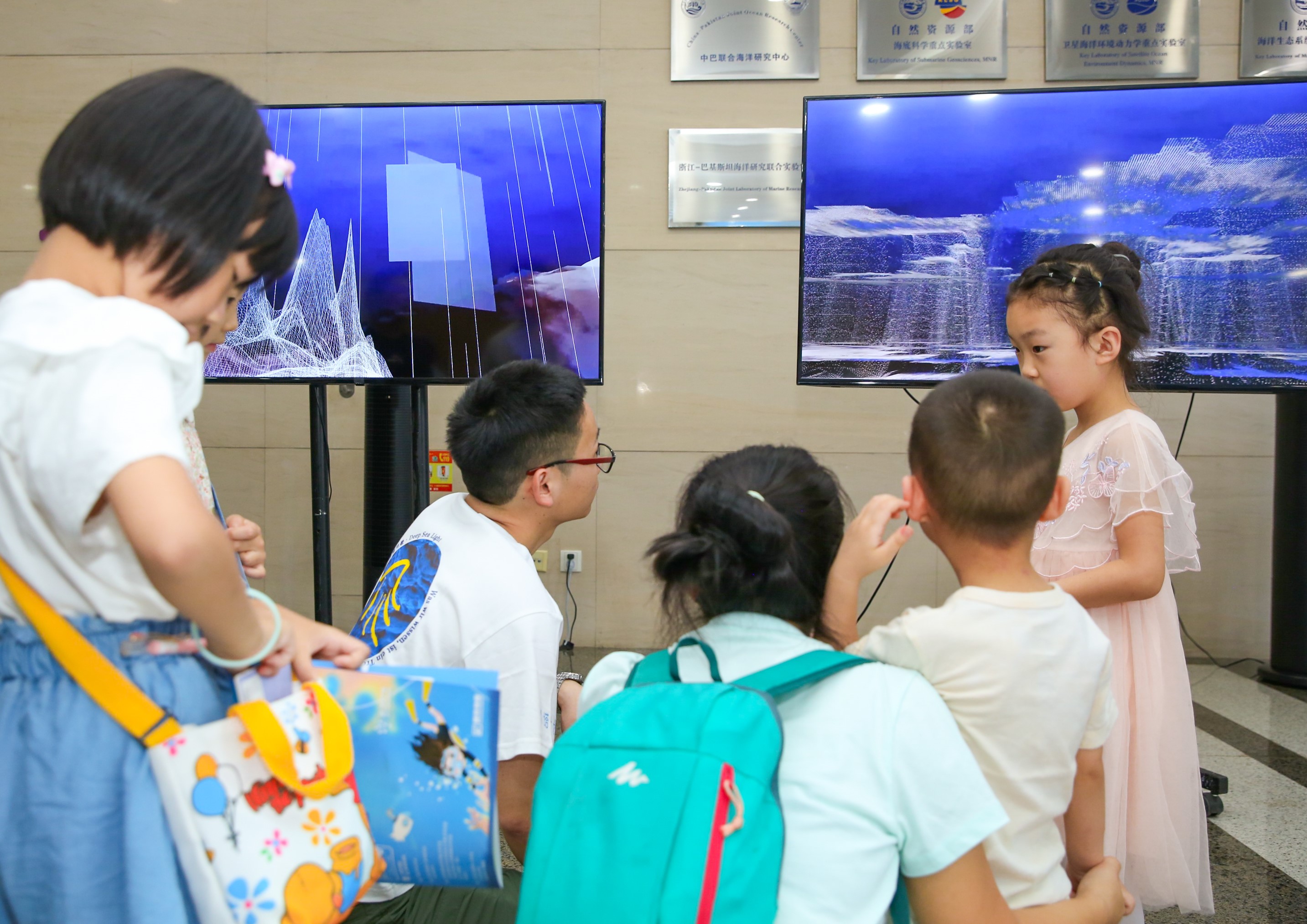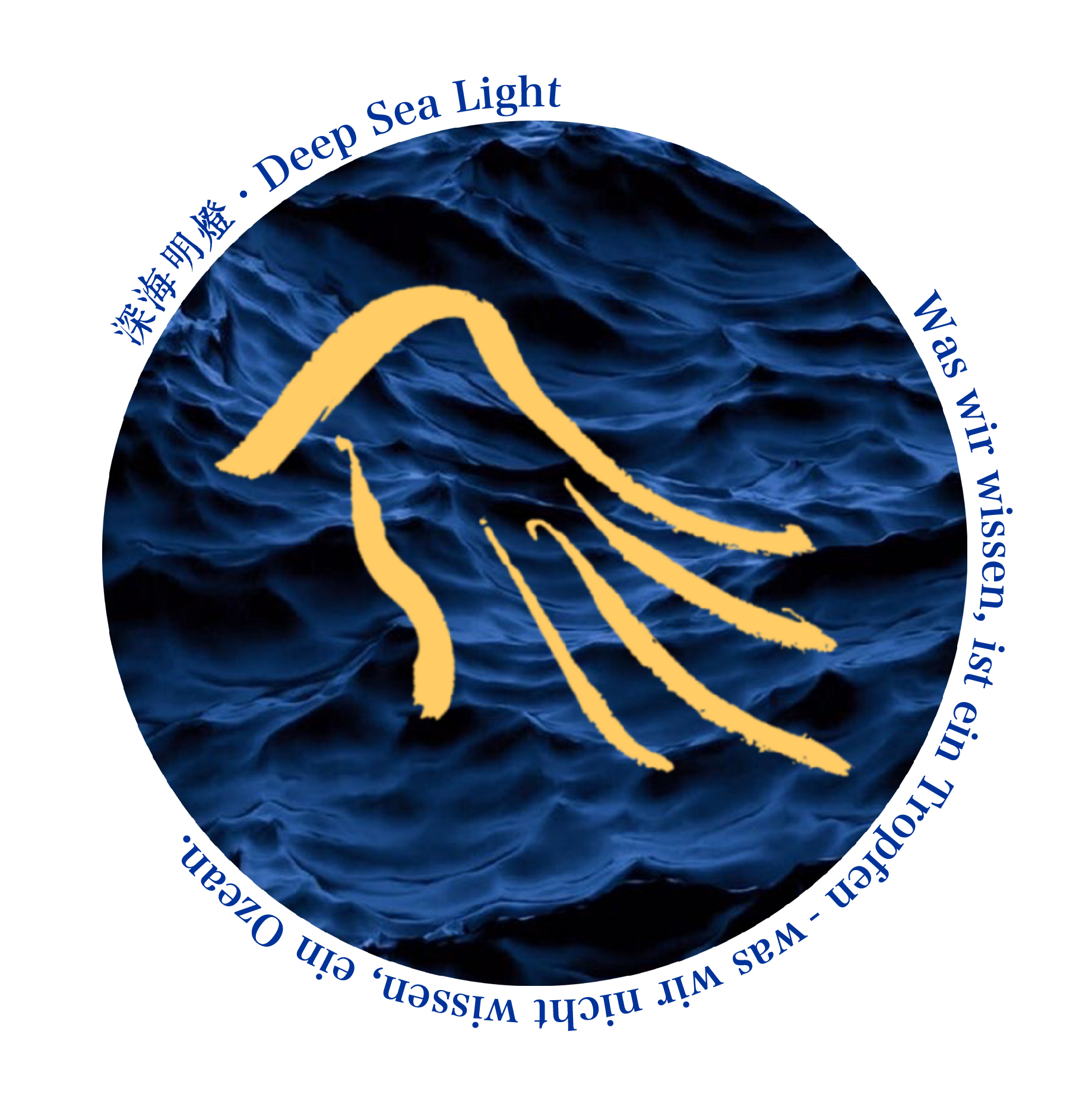‘What we know is a drop, what we do not know is an ocean.’ – Isaac Newton.
Marine science and art together – can that work at all? And what exactly is supposed to come out of it? With these questions in mind and a portion of scepticism, this spring I was on my way to an interview with Yu Ren and Sibiao Liu, both marine scientists at GEOMAR Helmholtz Centre for Ocean Research in Kiel. All they had told me beforehand was that they were working on a project on the interaction of deep ocean science and art, called Deep Sea Light, which combines new computer-assisted methods from both fields. During my background research I also found out that they had already won a prize with their work at the Jinan International Biennale 2022 exhibition. Now, let’s answer the questions, what exactly this is all about. Here is the interview.
Hello Yu and Sibiao, what exactly is your project Deep Sea Light about and what are the main ideas behind it?
Yu: As you mentioned, Deep Sea Light is the name of our project and the main idea behind it is to find a new way to illuminate the deep ocean in a way that makes it explorable for everyone. Because hearing and seeing are two very elementary ways of experiencing our environment, this gives us the opportunity to use these senses for exploring the ocean as a part of our environment. Only if we are able to experience something, we will have the chance to understand and care about it. To realise this, we use real, freely available scientific data from the deep sea, which are analysed and processed in a way that they become soundtracks and short video sequences.
By doing this, we hope to create a connection between the audience and the ocean with its organisms living within. Especially, if we talk about our planet or the world ocean, it is hard for people to understand that their activities and decisions can have an impact on them. But to be fair, this is not always obvious. The impacts of our actions are mostly not directly linked with the location or time. We hope that our art project can make this missing connection visible in a way that people start to realize this problem and think more about what they are doing.
Sibiao: Yes, this is the main goal we aim to achieve. Additionally, we also want to tackle with the project to see, if we can find a way to express difficult scientific research in a new and better understandable format for the public to raise their interest. This could raise awareness within the scientific community that we have a communication problem with the public and get their interest for new ways of communication. This is why working with the artists is so important; they have a completely unconventional view of content and can choose from a large repertoire of communication tools.

You mentioned soundtracks and video sequences. What exactly can we imagine by that?
Yu: After the identification of an interesting signal within the data, we transform it into audio and analyse its spectrum to determine its origin. The sources of these signals can be submarine volcano eruptions, airpulsers from research or industry vessels, seismic swarm signals from rising magma, movements within the crust, or even whale calls. As you can see, there is a hidden world of soundscape in the oceans. But we know little about it, as the range of frequencies of most sounds in the ocean are much lower than those we can hear.
The visualisation of the sounds should create a further deepening and consolidate the experience to make it more real, because there is something behind every sound. Let’s take the fin whale songs as an example. At the beginning, you hear a few sounds and cannot yet concretely imagine where the sounds come from and you see a cloud of dots. After a few seconds it becomes clear that it is the song of a whale, the dots take on the outline of a whale and after a while the fin whale becomes visible, it is slowly disappearing into the vastness of the ocean.
Sounds such as the melting of glaciers are a great way to highlight current issues, that are still neglected or not fully accepted within the society. The sound of the melting inside the data, cannot be denied and exhibits that this is a real ongoing process. Hopefully, this leads people to the understanding that we have to take actions regarding climate change. Until now, we have identified a wide range of acoustic signals, such as the Tonga volcano eruption, whale calls, ship tracks, but are still digging more.
You both are scientists yourselves, but how big is the Deep Sea Light-Team and what is your background?
Yu: Currently, the team consists of six members – four scientists and two artists. The scientific group includes us two, Sibiao, me, and Chuanzhi Li from the Ocean University of China as well as Maochuan Zhang in the University of Washington, USA. Concerning our scientific subjects, I use data from geomorphology (study of landforms and landform evolution) and seismology (study of earthquakes and derived from them, the structure of the earth) for my research. Sibiao, on the other hand, uses numerical modelling to understand the dynamics of subduction zones and mid-ocean ridges. Chuanzhi is doing research on active tectonics (evolution, structure and change of the lithosphere). Maochuan is doing focal mechanism (description of the deformation in the source region of an earthquake) simulation. Basically, we cover a wide range of skills and techniques to simulate the Earth, but all of us have to mine the available data as a basis for our simulations. That’s our science group!
For the art part, we have Tian Wu from the Muthesius University of Fine Arts and Design, Kiel. He is mainly designing his art work by using a symbolic language. He uses images or characters to visualize and communicate rather abstract concepts or ideas in a way that is accessible for everyone. The second artist is Pengfei Yao, currently working as an artist in the V^Art Group in China. He visualises his art by creating virtual sequences, so-called “visualisation programming”. Therefore, he is mainly in charge of the artistic programming work.
Since the data we use for our project are first of all nothing more than a series of numerical values, we first have to transform them into sound or visual impressions to make them accessible. In the future, we want to go even one step further by making it interactive, such as if someone waves a hand or sings a song the art work will respond to it. Pengfei realizes this transformational and interactive process with his programming.

How did it start with Deep Sea Light and how did you find each other?
Yu: As a researcher, I am investigating the Blanco transform fault offshore Oregon in the USA by analysing acoustic signals from ocean bottom seismometers. These ocean bottom seismometers can record signals from earthquakes occurring within the oceans. But I found out that the instruments did contain additionally other acoustic signals from the soundscape of the ocean, such as fin whale calls and swarm signals from underwater volcanoes. When I firstly found these signals, I did not know where they came from or what I was looking at. Therefore, I analysed them and compared these with other sounds that have been recorded in the ocean. At the same time, I came across an article that scientists used a technique to make such acoustic signals audible. I thought, why not trying? So, I used the same technique. And then, I heard the whale calls and all the other sounds, thinking: Wow, a whole hidden soundscape! After my first excitement ceased, the question raised, what to do with it, because that cannot be everything…
Later I talked with Tian Wu, a close friend of mine about this experience. As he is an artist, he was directly interested and listened to it. Tian found it beautiful and understood that the sound is accessible to the general public and being a powerful tool for communication. He suggested that he might be able to add something on it. As a result, a very preliminary visualisation of the fin whale calls was drafted, based on the sounds, he was listening to. It did not take long to decide to team up to make some serious work out of it, making it more interactive and more engaging to the general public. At that time Pengfei was involved in the small project, and contacts to Maochuan, Sibiao and Chuanzhi came later.
In my investigation, I read that your work can be seen at the Jinan International Biennale 2022 exhibition and you have already been awarded a prize. What exactly was the prize about?
Yu: Indeed. This happened at a very early stage of the project and we a very grateful for the prize money. Without the prize money the project hardly has been realized. After forming the group, we came up with some ideas about what we wanted to do and that it should be interactive. Then we submitted our art work ideas and the existing drafts to the Jinan International Biennale 2022 exhibition. It is an international art exhibition. We also had the chance to join some competition called 2022 Beacon Programme, which is sponsored by Zhihu Inc., China. They awarded us one of the 2022 Beacon Prizes with 1 Million Yuan (About 130,000 Euro) funding for one year to develop our science-art work.
Sibiao: It should also be emphasised that the handling of data and computer techniques also played a crucial role. In addition to the artistic and communicative aspects, Deep Sea Light also deals with some challenges that arise in the context of Big Data. The raw data used are from open scientific data centres and obtained from global networks of instruments within the deep oceans. Generally, we can take advantage of this data sets by searching and extracting interesting data from them. The process of searching and extraction of the data is called Data Mining. As these data sets are really huge and the process can be rather time-consuming, therefore we use artificial intelligence and computer algorithms to optimize this process.

Anything I forgot to ask you? Something you want to add?
Sibiao: Maybe some words to the logo of Deep Sea Light. If you look at the logo you find three different languages on it: Chinese, German and English – because we want to express that we are doing science and art in a multi-cultural context. We also have the yellow hand on it, which means the light in German sign language. We hope that everyone can understand the oceans directly. There should be not a border for culture and knowledge. The Chinese character stands for Deep Sea Light. As the name says we want to shine the light into the darkness of the missing understanding of the deep sea to make the deep sea accessible for everyone.
Yu: The German quotation is from Sir Isaac Newton: “What we know is a drop, what we don’t know is an ocean.”
Sibiao: The quote shall remind us that we know only a little about the ocean, and we, as scientists, only investigate a small piece of it in a very specific field. But the ocean is so large and the missing understanding is thus so large. So, the sentence gives us a good comprehension.
Yu: Maybe another topic. Most people believe that the ocean is ambient. I hope that our art project can change the view and stress out that it is actually quite noisy. Now people are saying, we have to protect the animals, but neglect noise pollution by vessels or other human activities that can impact the animals. By listening to the soundscape, people might get an idea from the perspective of marine animals. We impact the ocean via so many unknown ways. Some scientists believe that the ocean is much noisier than twenty years ago – we might be able to testify this theory by the end of this project.
Thanks for the interview!
I hope You found the conversation with Yu and Sibiao as interesting and exciting as I did. My scepticism vanished and I am now very curious about new ways of communication. Maybe you also have creative ideas on how to communicate scientific content, if so, I would be very happy if You could share these with us.
Until then, have a great summer! – Helene Hilbert
